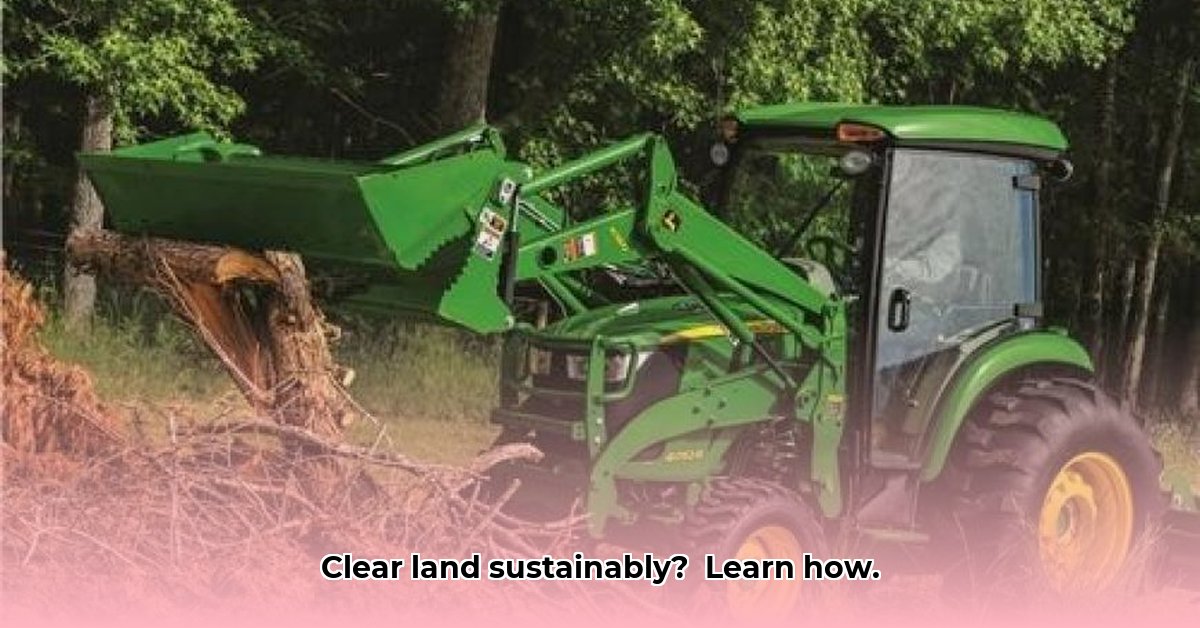
Dreaming of a sustainable farm? Land clearing is the crucial first step. This guide shows you how to clear land efficiently and sustainably using a compact tractor, from choosing the right equipment to managing debris responsibly. Whether you're experienced or a beginner, we'll equip you with the knowledge and confidence to prepare your land successfully. This process minimizes environmental impact and sets the stage for a thriving, eco-friendly farm. For more detailed information, check out this comprehensive guide.
Choosing Your Tractor and Attachments: The Right Tools for the Job
Selecting the right compact tractor and attachments is paramount for efficient and sustainable land clearing. The size and power of the tractor should match the scale and difficulty of your land. Consider these key factors:
- Horsepower: Higher horsepower means more power for tackling tough terrain and dense vegetation. A more powerful tractor will be more efficient but also more expensive to operate.
- Size: Choose a tractor that's appropriate for your land size and terrain. A larger tractor might be cumbersome in a small area. A smaller tractor may struggle with challenging tasks in larger areas.
- Budget: Compact tractors vary widely in price. Balance your needs with your budget – consider leasing if purchasing is outside your means.
Attachments are the workhorses, significantly expanding a compact tractor's capabilities. Here's a breakdown of common attachments and their uses:
| Attachment | Description | Best Suited For | Sustainable Considerations |
|---|---|---|---|
| Rear Blade | Levels land, removes debris, creates paths. | General land clearing, leveling uneven surfaces | Minimizes soil disturbance, reduces erosion. |
| Box Blade | Fine-grades land, removes rocks and smaller debris. | Fine-grading, creating a smooth surface, improves soil structure | Avoids excessive topsoil removal, maintains soil health. |
| Rotary Cutter | Mows down brush, small trees, and weeds. | Clearing overgrown areas, brush and weed control | Reduces waste by mulching vegetation. |
| Grapple/Loader | Picks up and moves large debris (logs, rocks.) | Moving and clearing large obstacles, debris removal | Efficient debris removal, minimizes transportation needs. |
Selecting the right combination depends on the land's condition and vegetation. Research your specific needs before purchasing.
Pre-Clearing Preparation: Planning for a Safe and Efficient Process
Thorough preparation is crucial for safety and efficiency, ensuring a smooth land clearing operation. Don't skip this step!
- Survey the Land: Before you start, carefully survey your land to locate underground utilities (power lines, gas, water pipes). Contact utility companies to mark their locations to avoid costly and potentially dangerous accidents.
- Obtain Necessary Permits: Check with your local authorities to determine if you need permits for land clearing. Requirements vary by location. Non-compliance can result in fines and legal complications.
- Develop a Clearing Plan: Map out your clearing process step-by-step, including starting points, task order, and debris management. A well-defined plan minimizes wasted time and effort.
Always wear appropriate safety gear: gloves, eye protection, hearing protection, sturdy clothing, and a high-visibility vest. This protects you from injury during the potentially hazardous land clearing process.
Step-by-Step Land Clearing Process: A Practical Guide
This section outlines a systematic approach to land clearing, emphasizing sustainable practices at each stage. Remember: safety first!
- Initial Clearing: Begin by removing large obstacles (trees, large rocks). If you lack experience with tree removal, hire a professional arborist to prevent injury and equipment damage. Isn't it worth the investment to ensure a safer operation?
- Brush Removal: Use the rotary cutter to clear smaller brush and weeds. Overlap passes for thorough clearing. Taking your time reduces the risk of uneven cutting and missed areas.
- Debris Management: Use the grapple and/or loader to gather and move debris. Sustainable practices suggest chipping brush (for mulch) or composting organic materials to enrich your soil. Burning debris is generally discouraged due to environmental concerns and potential legality issues. Did you know that composting can improve soil health by up to 25%?
- Leveling the Ground: Use the rear or box blade to create a smooth, even surface, reducing erosion risk. This prepares the land for planting and other activities.
- Final Inspection: Meticulously check the cleared area for any remaining obstacles, ensuring it's safe and ready for the next phase.
Post-Clearing Procedures: Sustainable Practices for Long-Term Land Health
Sustainable land clearing goes beyond removing vegetation; it involves careful post-clearing management. This ensures long-term land health and productivity.
- Soil Testing: Conduct a soil test to determine its composition and nutrient levels. This guides the selection of appropriate soil amendments. Soil testing is a fundamental step in sustainable agriculture—is your soil ready?
- Erosion Control: Implement erosion control measures (cover crops, erosion control blankets). This protects topsoil and prevents nutrient loss. Erosion control is vital; without it, you risk significant soil loss and reduced productivity.
- Sustainable Debris Management: Composting or chipping enhances soil fertility, reducing the need for chemical fertilizers. Composting returns valuable nutrients to the soil, improving long-term soil health.
Tractor Maintenance and Safety: Ensuring Safe and Efficient Operation
Regular maintenance is crucial for your tractor's longevity and your safety.
- Follow Manufacturer's Recommendations: Adhere to the manufacturer's maintenance schedule for oil changes, filter replacements, and other essential servicing. Proper maintenance prevents costly repairs and extends equipment lifespan.
- Regular Inspections: Inspect your tractor before each use, checking fluid levels, tires, and overall condition. Regular checks identify issues early and prevent breakdowns.
- Professional Maintenance: Periodically consider professional maintenance for larger repairs. Expert servicing ensures your tractor operates at its best.
Conclusion: Successful Land Clearing for Sustainable Farming
Clearing land with a compact tractor can be an efficient and sustainable process. By following this guide, planning properly, and prioritizing safety, you can create a robust foundation for a thriving and eco-friendly farm. Remember, sustainable practices lead to healthy soil, successful harvests, and a positive environmental impact. Happy farming!